Evolution of Collar Insignia
This page will focus primarily on the infantry collar insignia. To a lesser degree, insignia of the other branches of the French army will be covered as well.
Click on pictures for larger size image.
Note: All images used without permission. Original sources are cited at bottom of page.
Infantry Collar Insignia
Like the entire French uniform, the unit collar insignia (pattes de collet) went through great changes during the war, largely in tandem with changes to the regulation greatcoat. In 1914, the collar insignia was the highly conspicuous version first created immediately after the Franco-Prussian War. An order dated 7 October 1871 specified that all units in all branches of service would receive a collar patch with the unit number cut out in a different colored cloth, both in wool. A pair of insignia would be worn on both the greatcoat and the jacket collars.
For the Model 1871 collar insignia, the cloth backing (écousson) was cut from madder red (garance) 35 mm high and 40, 65 or 80 mm long, according to the number of digits composing the unit number (1, 2 or 3). The outside end of the backing terminated in a 3-pointed accolade. On these patches were sewn the unit digits in iron-blue gray (gris de fer bleuté) -- the same dark indigo-blue used in the greatcoat and jacket. The digits were die-cut at a height of 25 mm. The collar insignia for the jacket was cut at the height of 30 mm and these digits were made in dark blue. Of course, in the hectic days of mobilization, divergences from the regulations were common. Digits cut from dark blue versus iron-blue gray can be found, along with digits cut by hand using scissors versus die-cut digits.
Examples of the Model 1871 madder red infantry collar insignia worn in 1914. This series demonstrates the variations seen between the regulations and the reality. The digits of the 73 RI have been hand-cut and those of the 133 RI have been cut out of dark blue cloth and not iron-blue gray.

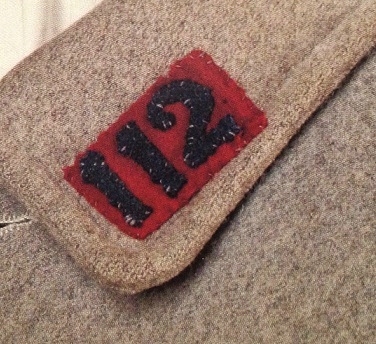 With the introduction of the new light blue uniform cloth in the fall of 1914, the first modification to the collar insignia occurred. The order of 19 September 1914 that described the new simplified uniform also saw the adoption of collar patch lacking the accolade outside edge, instead taking the form of a simple rectangle though still cut from madder red cloth. The order also stated that only one collar patch was to be worn, on the left side of the collar.
In practice however, many cases exist of the old collar insignia being retained and sewn onto the new garments. Sometimes, only the iron-blue gray digits were retained and sewn directly onto the collar with no backing. The form of the new collar insignia fit poorly with the fall-down collar of the new greatcoats and the positioning of the patches on the collars varied widely. Some were sewn down lining up on the point of the angle of the collar, per regulations. Others were lined up along the length of the collar edge in one way or another.
With the introduction of the new light blue uniform cloth in the fall of 1914, the first modification to the collar insignia occurred. The order of 19 September 1914 that described the new simplified uniform also saw the adoption of collar patch lacking the accolade outside edge, instead taking the form of a simple rectangle though still cut from madder red cloth. The order also stated that only one collar patch was to be worn, on the left side of the collar.
In practice however, many cases exist of the old collar insignia being retained and sewn onto the new garments. Sometimes, only the iron-blue gray digits were retained and sewn directly onto the collar with no backing. The form of the new collar insignia fit poorly with the fall-down collar of the new greatcoats and the positioning of the patches on the collars varied widely. Some were sewn down lining up on the point of the angle of the collar, per regulations. Others were lined up along the length of the collar edge in one way or another.
On 2 November 1914, the perhaps somewhat hasty decision was made to abolish collar patches all together. Instead a single unit insignia patch would be worn on the left breast of the greatcoat. But compliance of this order was exceptionally rare and it largely went ignored. A new collar insignia was soon adopted on 9 December 1914. One proposition approved by General Joffre was for each branch of service to have its own unique color of cloth backing. For all infantry units, it was daffodil yellow (jonquille). The digits would be cut from dark blue cloth and two soutaches (wool or cotton) of varying shades of blue were sewn closed to the outer edge. The accolade end was reintroduced (though at the end of January 1915 it was decided that the insignia for the jacket would not have accolade insignia). The new daffodil color though becomes easily dirtied and the color quickly fades to a dingy yellow. Certain officers also denounce the new color as being too vibrant and conspicuous. This unfortunate feature wasn’t missed by the men either and only served to remind them of the vast distance between the general staff and the reality of the war.
Examples of the daffodil-yellow infantry collar insignia. On the left: collar insignia with accoladed end and soutaches. On right: simplified non-accoladed insignia. On bottom: a simplified rectangular insignia with no soutaches.
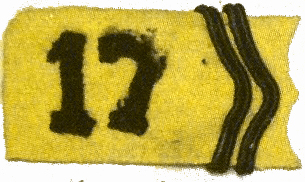
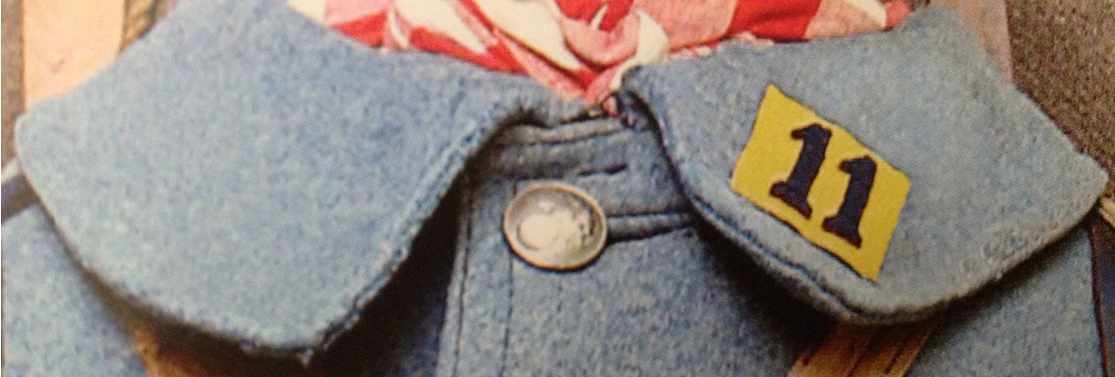.png?dl=0)
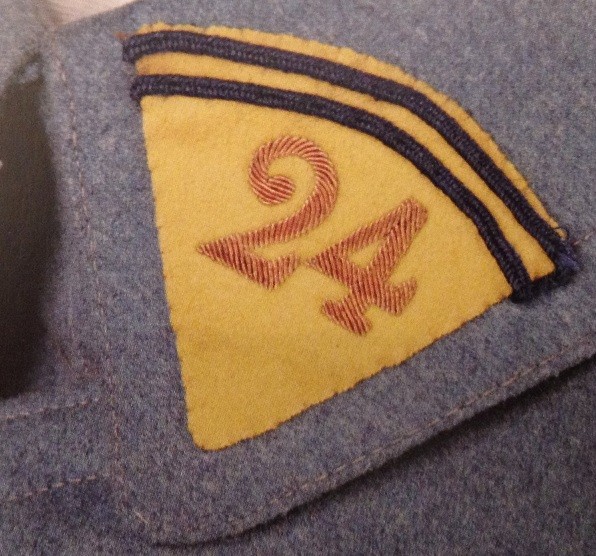.jpg?dl=0)

By March 1915, General Joffre became more attentive of the uniform cloth of his infantry forces and suggests adopting a new model of insignia in light blue cloth with the digits, soutaches and accoladed end unchanged. This is officially approved on 16 April 1915. This model is worn conjointly with a simplified model that saw great use until 1917, composed of cut digits on a simple rectangular cloth backing lacking any soutaches.
Examples of the light-blue / horizon-blue infantry collar insignia used from the summer of 1915 until the end of 1916.

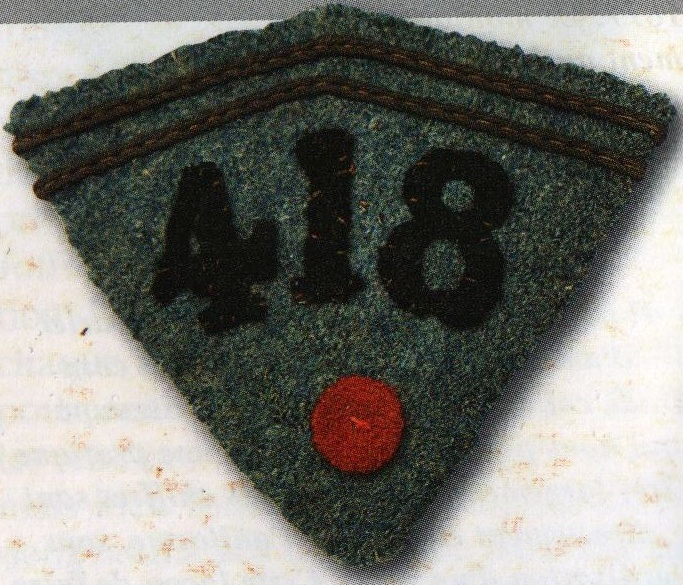 On 26 July 1916 a battalion identification consisting of colored cloth discs, which were to be added to the unit collar insignia. Dark blue would represent the 1st battalion, madder red 2nd battalion, daffodil yellow 3rd battalion. The discs were to be placed above the collar insignia on the greatcoat and adjacent to the insignia on the jacket. Initially, the regulation was not widely followed. It will not be generally followed until the beginning of 1918, and even then sporadically. When the discs were applied, they were typically sewn directly onto the cloth backing of the collar insignia. In order to remedy the lack of uniformity in the positioning of the collar insignia on the greatcoat collars, a new and final model of collar patch is adopted on 10 January 1917.
On 26 July 1916 a battalion identification consisting of colored cloth discs, which were to be added to the unit collar insignia. Dark blue would represent the 1st battalion, madder red 2nd battalion, daffodil yellow 3rd battalion. The discs were to be placed above the collar insignia on the greatcoat and adjacent to the insignia on the jacket. Initially, the regulation was not widely followed. It will not be generally followed until the beginning of 1918, and even then sporadically. When the discs were applied, they were typically sewn directly onto the cloth backing of the collar insignia. In order to remedy the lack of uniformity in the positioning of the collar insignia on the greatcoat collars, a new and final model of collar patch is adopted on 10 January 1917.
This insignia was "lozenge" shaped, 90 mm wide and 70 mm high, and was adorned with two soutaches along the top end. The digits were reduced in size to 20 mm for the greatcoat. The cloth backing on some versions had straight edges with pointed corners, while others had more rounded lines and corners. The collar insignia for the jacket remained unchanged. As with the rectangular collar insignia, the battalion discs were typically sewn directly onto the cloth backing, but below the unit number on the new insignia shape.
Above: the lozenge style infantry collar insignia with a battalion disc indicating 2nd battalion. Below: infantry collar insignia reflective of 1917-18. The lozenge model for the greatcoat and non-accoladed model for the jacket. The battalion discs indicate the 3rd battalion.
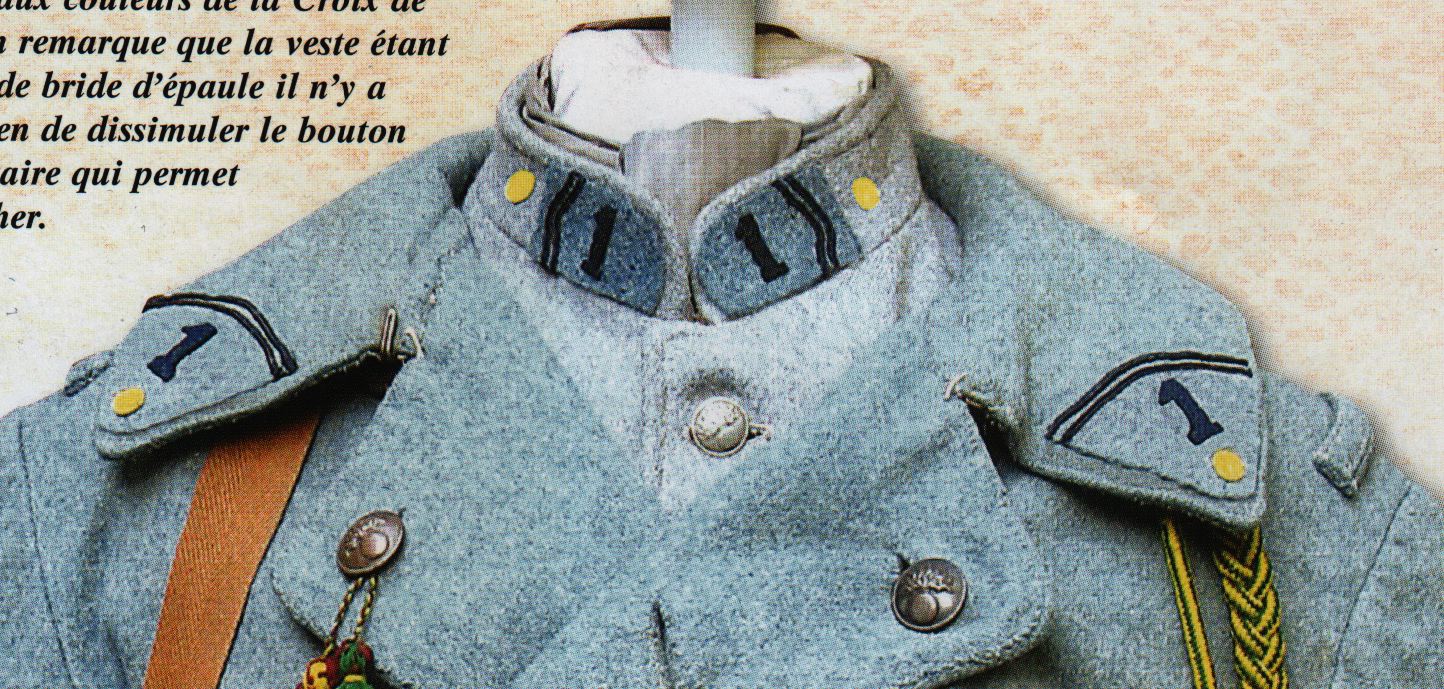
The following graph shows the evolution of infantry collar patches throughout the war. Note the black and white color conversion in the right-hand column. (Click to enlarge)
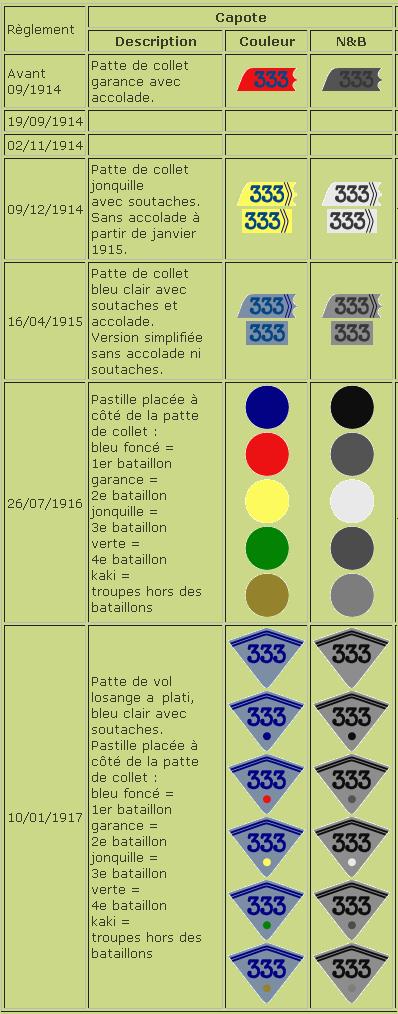
The evolution of collar insignia for NCOs and officers largely adhered to that of the enlisted men, though that the former more refined and generally of a nicer quality. There was also a great variance in styles, as most insignia were paid for by the officer's own means. In 1914, officers wore collar insignia with a dark blue (for overcoats) or black (for tunics) backing usually of a fine grade of wool. The shape was similar to the enlistedmen's, with a 3-pointed accoladed outer end. Later, simple rectangular cuts were also seen. Normally, the digits were either embroidered onto the backing (with gold or silver cannetille) or were stamped metal insignia (brass, copper or silver/gold plated). In theory, the color was dictated by the button color of the uniform. For the metal insignia, these could either have a smooth face or a textured (striped) surface. The digits were typically around 17 mm high.
The NCO's insignia were generally the same as the enlistemen's but the digits were more typically gold or silver cannetille (the color depending on the button color of the service branch). Stamped brass digits were sometimes also worn by NCOs.
The following images are provided here for general reference on other French army insignia of 1914-18.
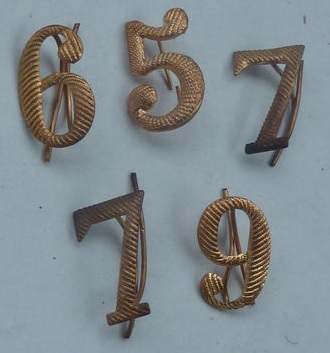
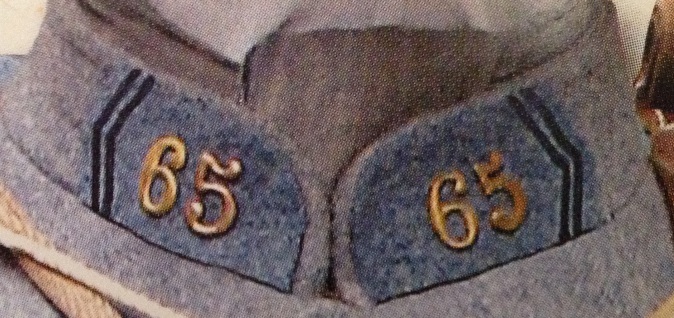
Various officer's insignia in gold or silver cannetille and gold or silver-plated metal.
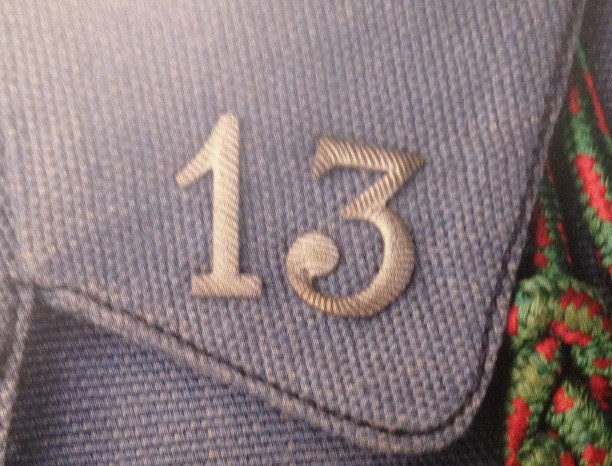.jpg?dl=0)
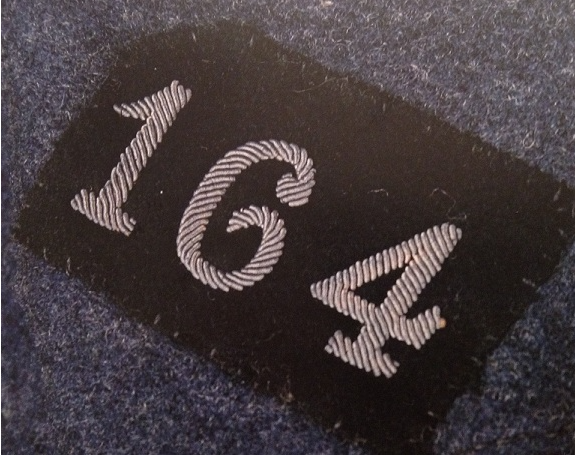.png?dl=0)
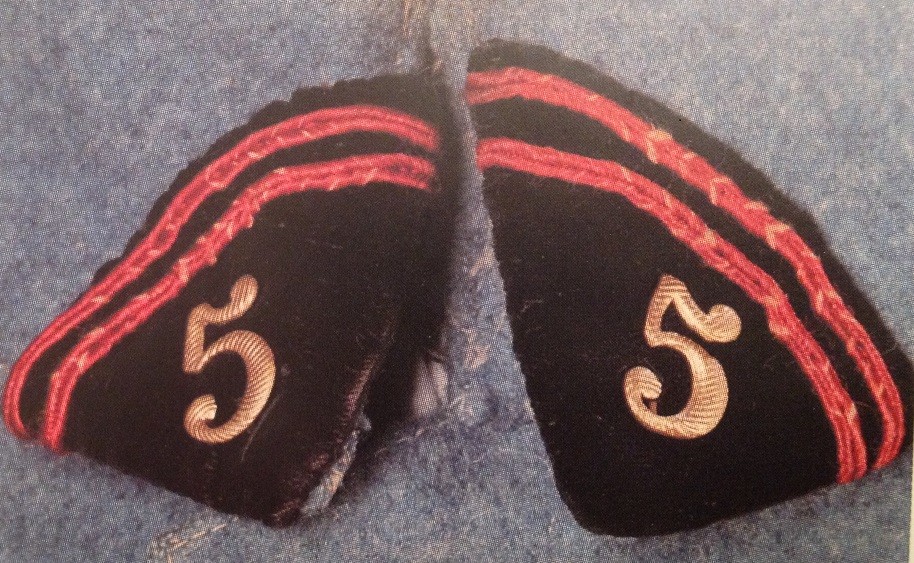.jpg?dl=0)
Pre-war artillery collar patches.
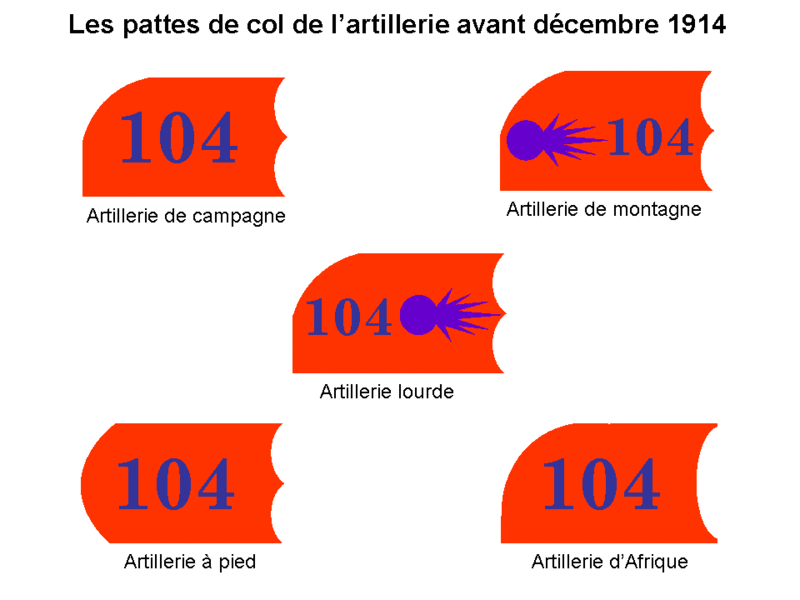
Infantry collar patches, Dec. 1914 to April 1915.
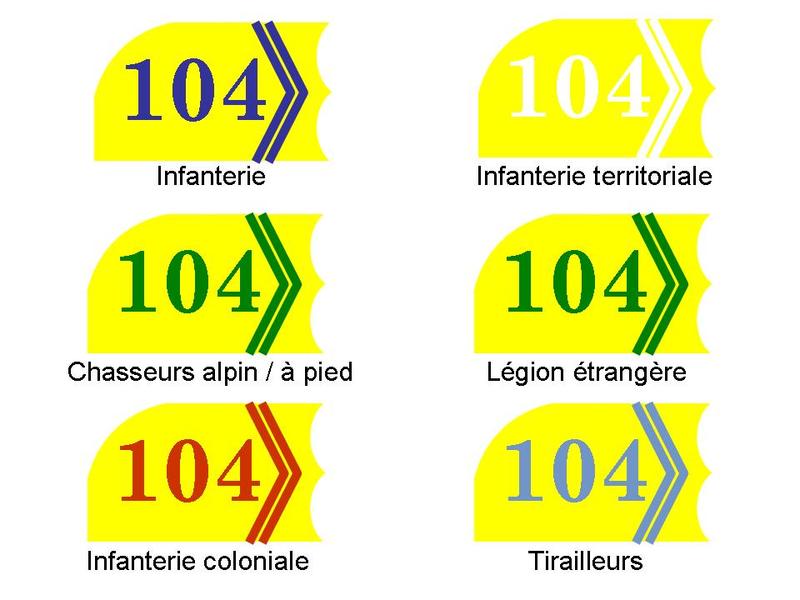
All branches collar patches, April 1915 to Jan. 1917.
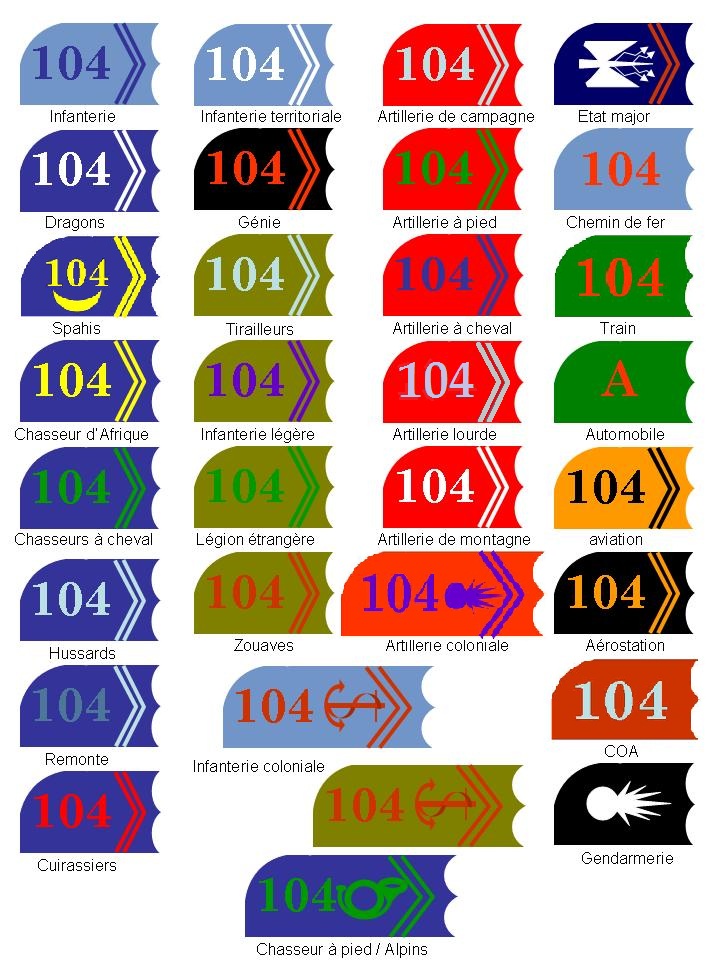
Medical officers collar patches. Clockwise from top left: pre-war model, Dec. '14 to Jan. '15, pharmacist model, Jan. '15 forward model.






